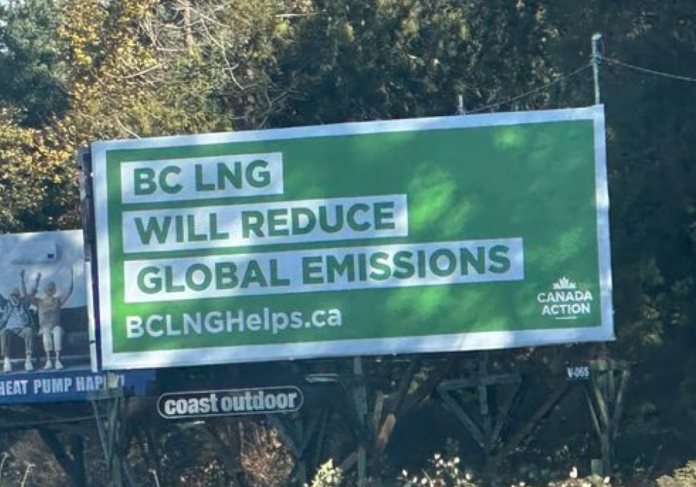Many Victorians who frequently traverse the Pat Bay Highway or the Trans-Canada Highway will have noticed the green pro-liquid natural gas (LNG) billboards lining the routes.
They read, “BC LNG will reduce global emissions.”
A bold statement on behalf of an industry that is currently being pushed out by many municipalities across BC and the rest of Canada in favour of having people switch their homes’ heat source to heat pumps.
Just this year on Vancouver Island alone, Nanaimo and View Royal have banned the inclusion of natural gas hookups in new construction.
Victoria made the move to ban natural gas hookups in new construction last year, but the implementation of this bylaw won’t come into effect until 2025.
LNG in BC
LNG is the supercooled form of natural gas which is held at -162°C and is typically composed of between 85 and 95% methane.
Methane is one of the most harmful greenhouse gases (GHG) and one of the largest contributors to climate change over the last several decades.
According to the British Columbia Energy Regulator, reducing methane emissions is one of the most effective ways to reduce greenhouse gases in our atmosphere.
There are over 44,000 kilometres of pipelines throughout the province to transport the resource to customers and export facilities.
However, some pipelines such as the Coastal GasLink project have come under mass scrutiny by activists due to the environmental impacts this project will have on the delicate ecosystems it crosses through.
It has been produced in BC since the 1950s and has helped the Province’s economy through job creation, royalties and revenues.
Nowadays, energy companies are trying their best to conserve emissions through gas capture, leak detection and repair program improvements, but some natural gas is still lost into the atmosphere.
Lately, companies like FortisBC have been trying their hardest to invest in renewable natural gas (RNG) which is collected from places like landfills where methane is emitted from decomposition and it can be captured and processed.
This process reduces the emissions of methane into the atmosphere; however, the burning of natural gas produces carbon dioxide which is still a massive contributor to climate change.
Who put up these pro-LNG billboards?
The billboards that line BC highways in Victoria were put up by Canada Action. They are an organization that lobbies the government for energy funding.
They lobby for almost every type of resource-based funding from solar energy to oil and gas.
Canada Action created the website BCLNGhelps.ca, where they make bold claims as to how Canadian LNG might help the world at large.
They claim that:
- Canadian LNG will reduce global GHGs by taking over for coal-fired power in Asia
- BC LNG projects will create hundreds of billions of dollars for Canadians and Indigenous Peoples while promoting economic reconciliation with First Nations communities.
- Additional Asian countries are interested in Canadian LNG
The billboards in Victoria were strategically placed to catch the eyes of MLAs and other government workers on their way to the city from the ferry and up island.
Canada Action also contradicts their own stances on several occasions. They lobby for the reduction of GHG producing industries in some of their campaigns while simultaneously lobbying the government for increased funding for the oil industry.
BC’s stance on LNG and a clean energy future
Victoria Buzz reached out to BC’s Ministry of Environment and Climate Change to ask their stance on LNG projects and how the industry aligns with the Province’s CleanBC climate plan.
“We have been clear all along that any future LNG project needs to fit within our conditions, including our climate commitments,” said a Ministry of Environment and Climate Change spokesperson.
The CleanBC plan aims to build a clean economy, create jobs and have industry standards shift closer to being net-zero in emissions.
What ‘net-zero’ means in terms of GHG emissions in Canada is that the company or industry either emits no GHGs or they offset their emissions.
In offsetting, the aim is to ‘cancel out’ the emissions produced. This can be done in a number of ways including reforestation, carbon capturing and investing in renewable energy projects like FortisBC is doing with their RNG endeavours.
BC’s Ministry of Environment and Climate Change says they are requiring all new LNG proposals to be net-zero by 2030, capping emissions for the oil and gas industry, fast-tracking clean energy and renewable electricity.
“The new framework will create certainty and help enable new investment in clean energy and industrial projects in BC,” said the Ministry spokesperson.
“Already, some of BC’s largest industrial operators – accounting for approximately half of all industrial greenhouse gas emissions – have committed to reaching net-zero by 2050.”
Ultimately, the Province aims to be a leader in that clean energy future.
Are the billboards accurate?
The signs along the highway claiming that “BC LNG will reduce global emissions,” may be misleading because this statement is only circumstantially true.
If countries who lean on coal power are to switch to using Canadian-made LNG, that would reduce global emissions, but methane and carbon will still be ending up in the atmosphere which will only contribute to the worsening of climate change here in Canada and across the globe.
These changes would also have to be implemented and championed by foreign governments who may be reluctant to push for the switch from coal to LNG.



